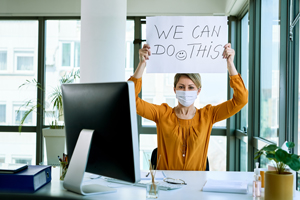
Pressure on leaders is only intensifying as we reel through successive waves of COVID, social upheaval, and political unrest. Some institutions face furloughs and layoffs; others, declining and unpredictable enrollment futures.
Leaders are struggling to adapt, recalibrating and reimagining what good performance looks like under circumstances that are changing on a day-to-day basis.
“If your culture wasn’t already designed to deal with the whole person in mind, you’re being forced to now,” said Monique Perry-Graves, Associate Vice President of Enrollment Management at York Technical College. “How do we manage these professional roles we’re all tasked with and compensated for, while still supporting employees?”
Perry-Graves offers these suggestions:
1. Be pro-active and empathetic.
“For example, employees may need permission to turn of their video during a large meeting,” Perry-Graves said. “Especially front-line or new employees may not know it’s O.K. to occasionally not be on video, and they may not be comfortable asking.”
Managers can be compassionate and flexible while still maintaining performance expectations. Some employees may work from a home environment that doesn’t lend itself to video calls, such as employees with kids at home or who are taking care of others.
2. Have clear boundaries.
Remember that you don’t have to be your employee’s therapist or best friend. You can be supportive to those who struggle without being a counselor.
“If you have employees who share a lot of emotions, it’s O.K. to set boundaries,” Perry-Graves said. “Over time leaders are bearing the brunt of supporting many people who are having a hard time, and it’s important to be clear about what you can and cannot do. Boundaries may need to be evaluated or reset.”
3. Put on your own oxygen mask first.
“You can’t provide leadership if you aren’t taking care of yourself — you can’t pour from an empty cup,” Perry Graves said. “You need to fill your own cup first to deal with the ongoing mental strain and fatigue. Find small ways to rejuvenate, such as taking a three-day weekend or making sure you have days where you’re entirely off-line. Look for the little joys.”
4. Give yourself some grace.
Leaders are often high-functioning and high-performing people. It’s not always easy when they discover they, too, are struggling. Recognize that the relentless stress takes its toll on even the strongest person.
“It’s not a sign of weakness,” Perry-Graves said. “You don’t need to feel guilty about taking care of yourself.”
5. Take the long view.
Recognize that the skills you are developing now will help you to be even stronger for future challenges.
“We’re going to be in this space for a while,” Perry-Graves said. “Hopefully we won’t have to use our pandemic toolkit again, but some of the muscles we’re growing and strengthening now will make our leadership even more robust, comprehensive, and resilient.”
Join colleagues for the free webinar “It's Complicated. Leading Performance with Compassion in a Remote Environment,” lead by Perry-Graves. Talk about how we lead ourselves, our teams, and our institutions through this uncharted territory. Register now for the October 22 webinar.